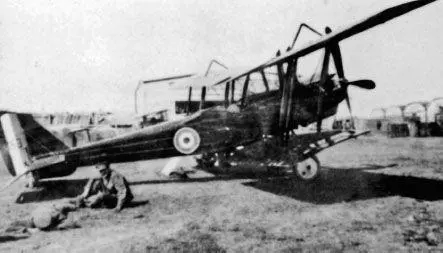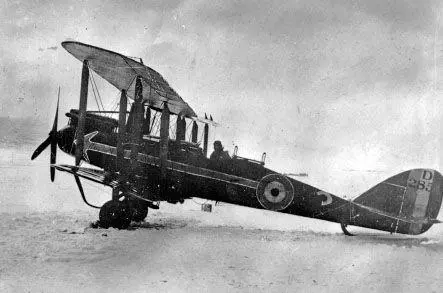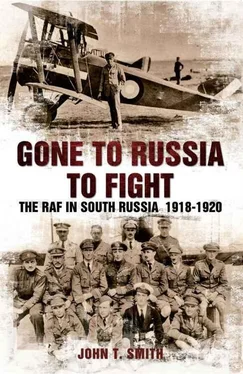THE AIRCRAFT USED IN SOUTH RUSSIA
RE8
Length: 27 ft 10 in. Span: (upper wing) 42 ft 8 in; (lower wing) 32 ft 7 in. Height: 10 ft 10 in.
Wing area: 377 sq. ft. Wing loading: 7.6 lb/sq. ft.
Engine: one 150 hp RAF 4a 12-cylinder Vee piston engine. Maximum speed: 102 mph.
Service ceiling: 13,500 ft. Weights: (empty) 1,800 lbs; (loaded) 2,896 lbs.
Endurance: 4.5 hours. Armament: one Vickers fixed forward-firing machine-gun and one Lewis gun on a Scarff ring in rear cockpit; 250 lbs bomb load.
The RE8 was introduced in late 1916 as a two-seat reconnaissance and artillery spotting aircraft. It was never a popular aircraft and had to be withdrawn soon after its introduction after a series of crashes. The tail section was redesigned and the aircraft reintroduced. In general, it was a very stable aircraft but slow to manoeuvre and a sitting duck for the newer German types. By the time production ceased, over 4,000 had been produced and well over 2,000 served on the Western Front, equipping most of the Army co-operation squadrons.
The main reason the RE8 was sent to Russia was that the new aircraft were available to be sent in quantity immediately. The Russians had constant difficulties with the RE8 and in the end refused to use them. A number of crashes took place, leading to accusations by the Russians that the British were getting rid of condemned aircraft and the accusation by the British that the Russians were incompetent. The RE8 was perhaps not the best aircraft to have sent to Russia. The aircraft pictured above is shown in Red air force markings and is one of the RE8s captured at Taganrog.

RE8, pictured at Taganrog.

DH9 number D2854, pictured on the ground at Petrovsk.
DH9
Length: 30 ft 9 in. Span: 42 ft 6 in. Height: 11 ft 7 in.
Wing area: 436 sq. ft. Wing loading: 8.4 lb/sq. ft.
Engine: one 230 hp Sidney Puma. Maximum speed: 111.5 mph.
Service ceiling: 17,500 ft. Weights: (empty) 2,300 lbs; (loaded) 3,670 lbs.
Endurance: 4.5 hours. Armament: one Vickers forward-firing machine-gun and one or two Lewis guns in rear cockpit; up to 460 lbs bomb load.
The DH9, built by De Havilland, was essentially a redesign of the successful DH4. But the DH9 ended up slower and less manoeuvrable than the aircraft it was replacing. On the plus side, the pilot and observer were now closer together for easier communications, and a heavier bomb load than the DH4 could be carried. The original engine for the DH9 was the 200 hp BPH, but this was chronically unreliable, leading to the loss of many aircraft in France. Over 2,000 were built and they were responsible for a large percentage of the bombs dropped on Germany in the last year of the First World War.
All the DH9s used in Russia were second-hand and were sent from RAF stocks in the Middle East. The Puma engine was more reliable than the original BHP, and the Russians much preferred the DH9 to the RE8.
DH9A
Length: 30 ft 3 in. Span: 45 ft 11 in. Height: 11 ft 4 in.
Wing area: 493 sq. ft. Wing loading: 9.5 lb/sq. ft.
Engine: one 400 hp Liberty. Maximum speed: 114 mph.
Service ceiling: 16,500 ft. Weights: (empty) 2,695 lbs; (loaded) 4,645 lbs.
Endurance: 5.75 hours. Armament: one Vickers forward-firing machine-gun and one or two Lewis guns on Scarff ring in rear cockpit; bomb load of up to 660 lbs.
The DH9A was a further development of the DH9, with increased wing span and the American Liberty engine. This gave the DH9A a longer range and a larger bomb load. The Liberty engine was efficient and reliable, and the DH9A served with RAF squadrons for many years after the end of the First World War. Number 221 Squadron was re-equipped with the DH9A and passed on its DH9s to the White Russian squadrons. Using the DH9A from Petrovsk to bomb Astrakhan meant that the intermediate airfield at Chechen Island was no longer needed because of the aircraft’s extra range.

A DH9A photographed on the ground at Petrovsk airfield.
A Flight of 47 Squadron was equipped with the DH9A while it was operating from Beketovka. This was a success while the flight was stationed at one place, and a large number of attacks on the Russian ships on the Volga took place. But when the squadron was on the move the more complex DH9A required an extra train to carry the necessary spares and equipment. A Flight’s aircraft were wrecked during the evacuation of Tagenrog. Like the DH9s, all the DH9As used in Russia were second-hand aircraft.
SOPWITH CAMEL
Length: 19 ft 6 in. Span: 28 ft. Height: 9 ft.
Wing area: 231 sq. ft. Wing loading: 6.4 lb/sq. ft.
Engine: one 130 hp Clerget Rotary. Maximum speed: 115 mph.
Service ceiling: 19,000 ft. Weights: (empty) 929 lbs; (loaded) 1,453 lbs.
Endurance: 2.5 hours. Armament: two forward-firing Vickers machine-guns; four 25 lb Cooper Bombs.
The Camel had the distinction of shooting down more aircraft during the First World War than any other fighter aircraft. First introduced into service in June 1917, the Camel was a highly manoeuvrable aircraft. But this manoeuvrability was bought at the cost of stability and for inexperienced pilots the Camel was something of a handful. Large numbers of Allied pilots were killed after losing control of the Camel. In the hands of an experienced pilot like Sam Kinkead, the Camel was a formidable opponent.
Captain Samuel Kinkead, standing next to his Sopwith Camel at Beketovka. The markings on the Camel are those of the Kuban air force.
A number of different engine types were employed in the Camel, but the ones used by 47 Squadron were Clerget-engined. One Bentley-engined Camel was taken to Petrovsk with 221 Squadron. Camels were also supplied to the White Russians and at least one Squadron, the 6th Don Squadron, used the type. All the Camels were alleged to have been destroyed during the evacuation, but there are photographs of at least one Camel in Red air force colours.
NIEUPORT 17
Length: 19 ft 7 in. Span: 27 ft. Height: 8 ft.
Читать дальше















